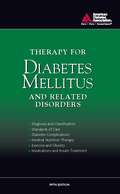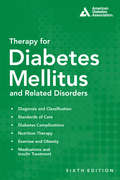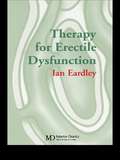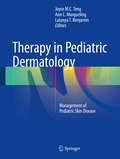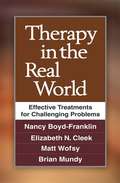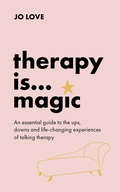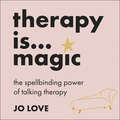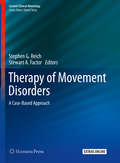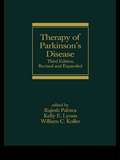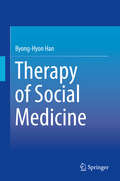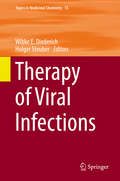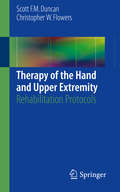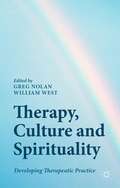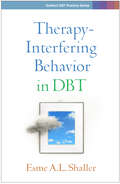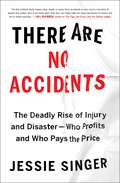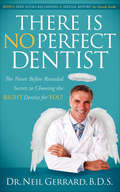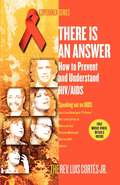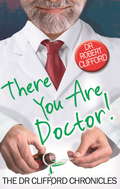- Table View
- List View
Therapy Tech: The Digital Transformation of Mental Healthcare
by Emma Bedor HilandA pointed look at the state of tech-based mental healthcare and what we must do to change it Proponents of technology trumpet it as the solution to the massive increase in the mental distress that confronts our nation. They herald the arrival of algorithms, intelligent chatbots, smartphone applications, telemental healthcare services, and more—but are these technological fixes really as good as they seem? In Therapy Tech, Emma Bedor Hiland presents the first comprehensive study of how technology has transformed mental healthcare, showing that this revolution can&’t deliver what it promises.Far from providing a solution, technological mental healthcare perpetuates preexisting disparities while relying on the same failed focus on personal responsibility that has let us down before. Through vivid, in-depth case studies, Therapy Tech reveals these problems, covering issues including psychosurveillance on websites like Facebook and 7 Cups of Tea, shortcomings of popular AI &“doctors on demand&” like Woebot, Wysa, and Joy, and even how therapists are being conscripted into the gig economy.Featuring a vital coda that brings Therapy Tech up to date for the COVID era, this book is the first to give readers a large-scale analysis of mental health technologies and the cultural changes they have enabled. Both a sobering dissection of the current state of mental health and a necessary warning of where things are headed, Therapy Tech makes an important assertion about how to help those in need of mental health services today.
Therapy for Diabetes Mellitus and Related Disorders
by American Diabetes Association Harold E. LebovitzLeading experts on diabetes mellitus share today's most effective diabetic treatments! Our newly revised 5th edition is your comprehensive guide to diabetes symptoms and current standards of care for Type 1, Type 2, and gestational diabetes.New diabetes treatment strategies include medical nutrition therapy with diabetes diet and exercise programs. Learn about our latest research on diabetes medication and technology with insulin-pump therapy, insulin secretagogues, incretin mimetics, and medications for obesity.Explore advances in type 1 diabetes prevention. Family care topic include diabetes in pregnancy, diabetic ketoacidosis, childhood obesity and type 2 diabetes in children. Other topics include glycemic control, diabetes complications and comorbidities, diabetes mellitus therapy in different patient groups and much more. This is an excellent resource for physicians seeking to provide the most current treatment for their patients.
Therapy for Diabetes Mellitus and Related Disorders
by Guillermo E. UmpierrezNearly 100 of the world's leading medical researchers and clinicians share their expertise on the diagnosis, treatment, and care of people with diabetes mellitus. This newly revised sixth edition is a comprehensive guide to type 1, type 2, and gestational diabetes. New diabetes treatment strategies include medical nutrition therapy with diabetes diet and exercise programs. This guide covers the latest research on diabetes medication and technology with insulin-pump therapy, insulin secretagogues, incretin mimetics, and medications for obesity, as well as advances in diabetes prevention. Family care topics include diabetes in pregnancy, diabetic ketoacidosis, childhood obesity, and type 2 diabetes in children. Other topics include glycemic control, diabetes complications and comorbidities, diabetes mellitus therapy in different patient groups, and much more. This is an excellent resource for physicians seeking to provide the most current treatment for their patients. Therapy for Diabetes Mellitus and Related Disorders is the most comprehensive clinical reference work available on the disease.
Therapy for Erectile Dysfunction: Pocketbook
by Ian EardleyErectile dysfunction is a common problem that may result from a number of medical conditions. With increasing public awareness, men with ED are seeking medical help. This pocketbook will assist the physician in treating and managing ED effectively with either drugs or devices.
Therapy in Pediatric Dermatology
by Joyce M. C. Teng Ann L. Marqueling Latanya T. BenjaminThis book addresses the need for comprehensive review of therapeutic options that are known to be efficacious in the management of cutaneous diseases in children. It summarizes evidence-based literature on clinical responses among pediatric patients, including age-appropriate management strategies. Included is review of the extraordinary developments in understanding of the genetics and pathogenesis of many cutaneous disorders during the past decade, the novel therapeutic options and repurposing of old drugs, and the management of some of the most challenging skin disorders. Therapy in Pediatric Dermatology: Management of Pediatric Skin Disease is a succinct, user-friendly, and up-to-date therapeutic dermatologic textbook for physicians who care for children with skin disorders. Each skin condition is discussed with investigative and treatment recommendations in mind and provided based on extensive review of the literature. This book will provide unbiased, yet concise, information that is valuable to practitioners who manage pediatric patients in their practices.
Therapy in the Real World
by Nancy Boyd-Franklin Matt Wofsy Elizabeth N. Cleek Brian MundyHelping beginning and experienced therapists cope with the myriad challenges of working in agencies, clinics, hospitals, and private practice, this book distills the leading theories and best practices in the field. The authors provide a clear approach to engaging diverse clients and building rapport; interweaving evidence-based techniques to meet therapeutic goals; and intervening effectively with individuals, families, groups, and larger systems. Practitioners will find tools for addressing the needs of their clients while caring for themselves and avoiding burnout; students will find a clear-headed framework for making use of the variety of approaches available in mental health practice.
Therapy in the Real World
by Nancy Boyd-Franklin Matt Wofsy Elizabeth N. Cleek Brian MundyHelping beginning and experienced therapists cope with the myriad challenges of working in agencies, clinics, hospitals, and private practice, this book distills the leading theories and best practices in the field. The authors provide a clear approach to engaging diverse clients and building rapport; interweaving evidence-based techniques to meet therapeutic goals; and intervening effectively with individuals, families, groups, and larger systems. Practitioners will find tools for addressing the needs of their clients while caring for themselves and avoiding burnout; students will find a clear-headed framework for making use of the variety of approaches available in mental health practice.
Therapy is... Magic: An essential guide to the ups, downs and life-changing experiences of talking therapy
by Jo LoveIn this part memoir, part mental health resource and how-to guide, Jo Love throws opens the door of her therapist's office and shines a light on what exactly goes on in the therapy room. With the help of experts, including her very own therapist, Jo opens a rare window into the real world of therapy, unpicking the magical powers that enabled her to re-find her own voice, restored her resilience through the cloudiest days and ultimately saved her from her own mind. Each chapter includes:- A therapy list where Jo shares her knowledgeable insights into therapy- Inspirational voices in the mental health space on the life-changing effects of therapy - A 'From the Other Chair' section featuring expert opinions from mental health professionals- 'Need Help Now' suggestions Therapy is ... Magic moves away from the stigma sometimes associated with seeking help, and shines a light on the emotional and physical benefits of talking therapies. Jo Love shows us that with professional guidance we can heal ourselves and the relationships we have, tackle addictions and trauma, and save our minds.
Therapy is... Magic: An essential guide to the ups, downs and life-changing experiences of talking therapy
by Jo LoveIn this part memoir, part mental health resource and how-to guide, Jo Love throws opens the door of her therapist's office and shines a light on what exactly goes on in the therapy room. With the help of experts, including her very own therapist, Jo opens a rare window into the real world of therapy, unpicking the magical powers that enabled her to re-find her own voice, restored her resilience through the cloudiest days and ultimately saved her from her own mind. Each chapter includes:- A therapy list where Jo shares her knowledgeable insights into therapy- Inspirational voices in the mental health space on the life-changing effects of therapy - A 'From the Other Chair' section featuring expert opinions from mental health professionals- 'Need Help Now' suggestions Therapy is ... Magic moves away from the stigma sometimes associated with seeking help, and shines a light on the emotional and physical benefits of talking therapies. Jo Love shows us that with professional guidance we can heal ourselves and the relationships we have, tackle addictions and trauma, and save our minds.
Therapy is... Magic: An essential guide to the ups, downs and life-changing experiences of talking therapy
by Jo LoveIn this part memoir, part mental health resource and how-to guide, Jo Love throws opens the door of her therapist's office and shines a light on what exactly goes on in the therapy room. With the help of experts, including her very own therapist, Jo opens a rare window into the real world of therapy, unpicking the magical powers that enabled her to re-find her own voice, restored her resilience through the cloudiest days and ultimately saved her from her own mind. Each chapter includes:- A therapy list where Jo shares her knowledgeable insights into therapy- Inspirational voices in the mental health space on the life-changing effects of therapy - A 'From the Other Chair' section featuring expert opinions from mental health professionals- 'Need Help Now' suggestions Therapy is Magic moves away from the stigma sometimes associated with seeking help, and shines a light on the emotional and physical benefits of talking therapies. Jo Love shows us that with professional guidance we can heal ourselves and the relationships we have, tackle addictions and trauma, and save our minds.
Therapy of Movement Disorders: A Case-Based Approach (Current Clinical Neurology)
by Stephen G. Reich Stewart A. FactorThis case-based text provides treatment approaches to common and uncommon movement disorders. The first two parts of the book are devoted to the wide spectrum of motor and non-motor problems encountered in caring for people with Parkinson’s disease, as well as Parkinsonian syndromes. Next are parts with chapters addressing essential and other tremor disorders followed by management of the various dystonic syndromes and other hyperkinetic disorders including chorea, tics, and myoclonus. Other disorders covered are drug-induced movement disorders, psychogenic movement disorders, Wilson’s disease, hemifacial spasm and more. Authored by experts globally, this practical guide will help physicians, other healthcare professionals and trainees care for patients with a wide spectrum of movement disorder related problems.
Therapy of Parkinson's Disease
by Rajesh Pahwa Kelly E. Lyons William C. KollerA comprehensive review of current tactics in the therapeutic management of Parkinson's disease, this volume offers summaries of salient research findings as well as contemporary attitudes and practical advice from field specialists. The well-timed Third Edition is expanded and topically reorganized to register trends and progress in anti-parkinsoni
Therapy of Skin Diseases
by Thomas Krieg David R. Bickers Yoshiki MiyachiBased on the understanding of the molecular basis of skin diseases, this truly international book supports the reader to understand the mode of action of new and established therapies. Thus, by explaining the molecular pathology with its applications for therapy, it provides the reader with an up-to-date knowledge of the therapy of skin disease and helps to understand ongoing and new developments in the field. Written and edited by international and renowned dermatology experts from Europe, America and Asia, it also includes regional concepts of therapies. The reader-friendly structure allows the reader to pick up the information quickly; for example, each chapter highlights practical hints for indications and applications. This lavishly illustrated book will support the reader to choose the most appropriate therapy for the patient and to reach a better treatment outcome. It will be an indispensable resource for dermatologists in university departments as well as in clinical practice.
Therapy of Social Medicine
by Byong-Hyon HanThis book introduces novel and groundbreaking theories on social medicine, social medicine therapy and pharmacogelotology. Aimed at improving the global health care system in terms of cost-effectiveness and efficiency, the research included in this book represents a paradigm shift from traditional drugs to social medicine. Tracing the history of social medicine, from Natural Healing Power (NHP), Oriental Medicine's vitalism, to Homeostasis (Natural Healing Strength) and Reciprocity (Social Healing Strength), the book first focuses on laying the theoretical foundations. It then highlights how social medicine can be specialized into various social medicine therapies (i. e. , aromatherapy, stone therapy, diet therapy, exercise therapy, light therapy, etc. ), just like stem cells. This is followed by arguments that 21st century pharmacy should be a harmonious system where the replacement of traditional drug products (i. e. , herbal, chemical, and biological products) with new social medicine takes precedence. To that end, the author focuses on the '4+2 system' with 4 representing diet, body, stress, and facial-image control, and 2 representing the complementary and alternative medical methods of evacuation(-) and filling(+). In the context of pharmacogelotology, the book then goes on to present findings on theories of laughter and laughter therapy practices, which are systematically examined and described in detail. Finally, it calls for the development of social-medicine structures by governments that aim to help local authorities use their resources effectively, and for local governments to establish the long-term planning on social-medicine therapy for healthy ageing.
Therapy of Viral Infections
by Wibke E. Diederich Holger SteuberMedicinal chemistry is both science and art. The science of medicinal chemistry offers mankind one of its best hopes for improving the quality of life. The art of medicinal chemistry continues to challenge its practitioners with the need for both intuition and experience to discover new drugs. Hence sharing the experience of drug research is uniquely beneficial to the field of medicinal chemistry. Drug research requires interdisciplinary team-work at the interface between chemistry, biology and medicine. Therefore, the topic-related series Topics in Medicinal Chemistry covers all relevant aspects of drug research, e. g. pathobiochemistry of diseases, identification and validation of (emerging) drug targets, structural biology, drugability of targets, drug design approaches, chemogenomics, synthetic chemistry including combinatorial methods, bioorganic chemistry, natural compounds, high-throughput screening, pharmacological in vitro and in vivo investigations, drug-receptor interactions on the molecular level, structure-activity relationships, drug absorption, distribution, metabolism, elimination, toxicology and pharmacogenomics. In general, special volumes are edited by well known guest editors.
Therapy of the Hand and Upper Extremity
by Scott F. M. Duncan Christopher W. FlowersPresenting over 100 rehabilitation protocols for the hand and upper extremity in an easy-to-use, step-by-step format, this practical reference provides surgeons and therapists alike with a go-to source for the therapy technique or strategy appropriate for their patients. Covering injuries from the shoulder, elbow, wrist, hand and fingers, each protocol includes bullet-pointed steps in daily or weekly increments following the injury or surgery and are inherently adaptable to the specific surgical intervention or rehabilitation requirement. Procedures following arthroplasty, extensor and flexor tendon injuries, fractures and dislocations, ligament and soft tissue injures, and nerve compression syndromes are among the many and multifaceted therapies presented. This book will be an invaluable resource for the orthopedic surgeon, hand surgeon, physical therapist, occupational therapist, hand therapist and any active clinician treating injuries to the hand and upper extremity.
Therapy, Culture and Spirituality
by Greg Nolan William WestThis edited collection addresses how therapy can engage with issues of race, culture, religion and spirituality. It is a response to the need for practitioners to further their understanding and skills base in developing ways of appropriately responding to the interconnectivity of these evolving issues.
Therapy-Interfering Behavior in DBT (Guilford DBT Practice Series)
by Esme A. ShallerTherapy-interfering behavior (TIB) is a key treatment target in dialectical behavior therapy (DBT), second only to suicidal thinking and self-harm. This wise, engaging book gives clinicians everything they need to assess, understand, and address TIB both in clients and in themselves. Therapists learn how to orient clients to TIB and work with it effectively whenever it shows up, using a combination of validation, contingency management, and dialectics. Packed with clinical examples, dialogues, and practical tips, the book discusses the full range of DBT contexts, from individual therapy to skills class, phone coaching, and consultation teams.
TherapyEd's National Occupational Therapy Certification Exam Review And Study Guide
by Rita P. Fleming-CastaldyThe NBCOT is a high stakes exam and TherapyEd new, 8th edition National Occupational Therapy Certification Exam Review and Study Guide is the ONLY book which combines comprehensive content review with challenging practice questions to help you pass the exam. The content review helps you know what to study and the practice exams give you feedback so you understand how you did, what your strengths and weaknesses are, and how to better prepare for the exam. This book now comes with an online access code in the back of the book for the exams in place of a USB drive.
There Are No Accidents: The Deadly Rise of Injury and Disaster—Who Profits and Who Pays the Price
by Jessie SingerA journalist recounts the surprising history of accidents and reveals how they&’ve come to define all that&’s wrong with America.We hear it all the time: &“Sorry, it was just an accident.&” And we&’ve been deeply conditioned to just accept that explanation and move on. But as Jessie Singer argues convincingly: There are no such things as accidents. The vast majority of mishaps are not random but predictable and preventable. Singer uncovers just how the term &“accident&” itself protects those in power and leaves the most vulnerable in harm&’s way, preventing investigations, pushing off debts, blaming the victims, diluting anger, and even sparking empathy for the perpetrators. As the rate of accidental death skyrockets in America, the poor and people of color end up bearing the brunt of the violence and blame, while the powerful use the excuse of the &“accident&” to avoid consequences for their actions. Born of the death of her best friend, and the killer who insisted it was an accident, this book is a moving investigation of the sort of tragedies that are all too common, and all too commonly ignored. In this revelatory book, Singer tracks accidental death in America from turn of the century factories and coal mines to today&’s urban highways, rural hospitals, and Superfund sites. Drawing connections between traffic accidents, accidental opioid overdoses, and accidental oil spills, Singer proves that what we call accidents are hardly random. Rather, who lives and dies by an accident in America is defined by money and power. She also presents a variety of actions we can take as individuals and as a society to stem the tide of &“accidents&”—saving lives and holding the guilty to account.
There Is No Perfect Dentist: The Never Before Revealed Secrets to Choosing the Right Dentist for You!
by Dr. Neil GerrardDon&’t brush off your dental health! Get tips on how to find the dentist who checks off all your boxes—for regular cleanings or special procedures. This book helps you with one of the most important health choices you will ever face. Whether you have an existing dentist who does not offer the type of care you require or whether you are looking to make a change, you want to choose a dentist you can trust, and who has your and your family&’s best interests at heart. With the myriad choices out there, it&’s hard to narrow down your options—even with personal recommendations and online reviews. There Is No Perfect Dentist gives you the knowledge to make an informed choice. It discusses where to look, what to expect from your first visit, the role of dental specialists and the dental team, how to deal with problems and disagreements, and even how to overcome dentophobia (the fear of dentists). Sink your teeth into There Is No Perfect Dentist and be happy with your smile!
There Is an Answer
by Luis CortesHIV/AIDS is a scary subject. Not only can it destroy a body but it can also destroy a family, friendships, and even a community. Nobody likes to talk about it, but ignoring the problem won't make it go away. In fact, what you don't know can hurt you and somebody else. The only way we can overcome this disease is through education, precaution, and proper treatment, because nobody is immune. The Reverend Luis Cortés teaches you how to understand the virus and the disease. Prevention is the best approach, but contracting HIV is no longer a death sentence. There are now a variety of treatment choices available and people are living with it, not dying from it. Above all, whether you or someone you know has HIV/AIDS, or you simply want to educate yourself, realize this: There is an answer.
There Is an Answer
by Rev Luis CortesHIV/AIDS is a scary subject. Not only can it destroy a body but it can also destroy a family, friendships, and even a community. Nobody likes to talk about it, but ignoring the problem won't make it go away. In fact, what you don't know can hurt you and somebody else. The only way we can overcome this disease is through education, precaution, and proper treatment, because nobody is immune. The Reverend Luis Cortés teaches you how to understand the virus and the disease. Prevention is the best approach, but contracting HIV is no longer a death sentence. There are now a variety of treatment choices available and people are living with it, not dying from it. Above all, whether you or someone you know has HIV/AIDS, or you simply want to educate yourself, realize this: There is an answer.
There Is an Answer
by Rev Luis CortesHIV/AIDS is a scary subject. Not only can it destroy a body but it can also destroy a family, friendships, and even a community. Nobody likes to talk about it, but ignoring the problem won't make it go away. In fact, what you don't know can hurt you and somebody else. The only way we can overcome this disease is through education, precaution, and proper treatment, because nobody is immune. The Reverend Luis Cortés teaches you how to understand the virus and the disease. Prevention is the best approach, but contracting HIV is no longer a death sentence. There are now a variety of treatment choices available and people are living with it, not dying from it. Above all, whether you or someone you know has HIV/AIDS, or you simply want to educate yourself, realize this: There is an answer.
There You Are, Doctor!
by Robert CliffordAs charming as he is entertaining, Dr Robert Clifford dispenses a delightful dose of hilarious anecdotes, colourful portraits of patients, family and friends, tempered with heartwarming tales of human courage and tragedy.There's the eccentric hermit Hamish Richardson; the stubborn Romany Zackovitch Hebden; Miss Peabody, the elderly spinster ever hopeful of a pools win; and William Jessop, the blind man whose handicap obviously isn't a handicap! As well as stories from his Tadchester surgery, Dr Robert Clifford tells of his son's accident on Sark and there are more fishy tales with water bailiff John Denton and a sparkling of delightful descriptions of holidays at home and abroad.Doctor, family man, humourist, philosopher and counsellor, Dr Robert Clifford's stories are a tonic for us all.

